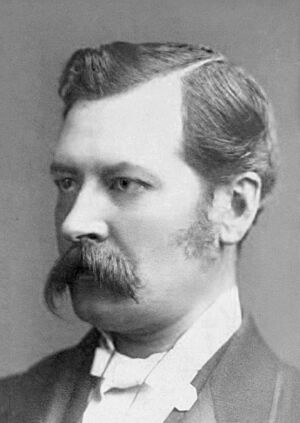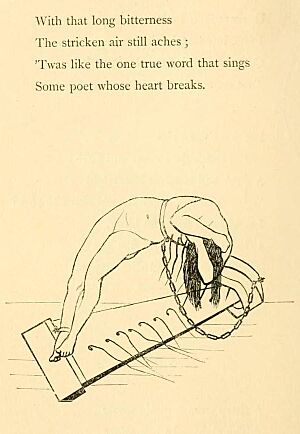Arthur O'Shaughnessy facts for kids
Quick facts for kids
Arthur O'Shaughnessy
|
|
|---|---|

O'Shaughnessy around 1875
|
|
| Born | 14 March 1844 London, England
|
| Died | 30 January 1881 (aged 36) London, England
|
| Spouse(s) |
Eleanor Marston
(m. 1873; |
| Children | 2 |
Arthur William Edgar O'Shaughnessy (born March 14, 1844 – died January 30, 1881) was a British poet and a scientist who studied reptiles and amphibians, known as a herpetologist. He was born in London and had Irish family roots. He is most remembered for his poem "Ode", from his 1874 book Music and Moonlight. This poem begins with the famous lines, "We are the music makers, / And we are the dreamers of dreams". Many composers, including Edward Elgar, have set this poem to music.
Early Life and Science Work
When Arthur O'Shaughnessy was 17, in June 1861, he got a job at the British Museum library. Two years later, he started working as a herpetologist in the museum's animal department. A herpetologist is a scientist who studies reptiles like snakes and lizards, and amphibians like frogs.
From 1874 until he passed away, he found and described six new types of reptiles. After his death, four new types of lizards were named oshaughnessyi in his honor. This is a special way scientists remember important people.
His Poetry
Even though he was a scientist, O'Shaughnessy's true passion was writing. He published his first collection of poems, Epic of Women, in 1870. Two years later, he released Lays of France (1872), and then Music and Moonlight in 1874.
He is best known for the first poem in Music and Moonlight, called "Ode". It starts with these famous lines:
We are the music-makers.
And we are the dreamers of dreams.
Wandering by lone sea-breakers.
And sitting by desolate streams;
World-losers and world-forsakers.
On whom the pale moon gleams
Yet we are the movers and shakers
Of the world for ever, it seems
When he was 30, he got married. He didn't publish any more poetry books for the next seven years of his life. His last book, Songs of a Worker, was published in 1881 after he had died.
O'Shaughnessy's poems were often ahead of their time. He explored how art and work are connected. Unlike some other poets of his time, he believed that writing poetry took hard work, not just sudden bursts of inspiration.
A famous writer named T. S. Eliot once said that even though O'Shaughnessy didn't write many good poems, "We Are the Music Makers" is so good that it should be in any collection of 19th-century poems.
Personal Life
O'Shaughnessy had many artist friends, including Dante Gabriel Rossetti and Ford Madox Brown. In 1873, he married Eleanor Marston. Her father was the author John Westland Marston, and her brother was the poet Philip Bourke Marston.
Arthur and Eleanor wrote a children's book together called Toy-land (1875). They had two children, but sadly, both of them died when they were very young.
Eleanor passed away in 1879. O'Shaughnessy himself died in London two years later, at the age of 36. He caught a bad cold after walking home from the theater on a rainy night, and it led to his death. He is buried in Kensal Green Cemetery.
Legacy
The writer Francis Turner Palgrave said that O'Shaughnessy had a special talent. He believed that O'Shaughnessy's gift was almost as great as the famous poet Tennyson, and that O'Shaughnessy had "a haunting music all his own."
O'Shaughnessy's translations of French poetry and the influence of French art styles on his own work helped set the stage for a new style of English art in the 1890s. He helped connect earlier art movements with newer ones.
O'Shaughnessy is remembered in the scientific names of four types of lizards: Calumma oshaughnessyi, Cercosaura oshaughnessyi, Enyalioides oshaughnessyi, and Pachydactylus oshaughnessyi.
Works
- An Epic of Women (1870)
- Lays of France (1872)
- Music and Moonlight: Poems and Songs (1874)
- Toy-land (with Eleanor W. O'Shaughnessy) (1875)
- Songs of a Worker (1881) (published after his death)


